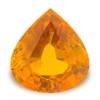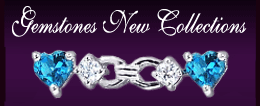Gemstone Reports »Swiss Gemmological Institute Lab Report (SSEF)
Swiss Gemmological Institute (SSEF) lab report
The Swiss Gemmological Institute, part of the Swiss Foundation for the Research of Gemstones (SSEF: Schweizerische Stiftung fur Edelstein-Forschung) was founded by trade organizations. The SSEF is supervised by a board of seven members who meet regularly to discuss the general policy and direction of the laboratory.
<Diamond Report:
Colorless to near colorless loose diamonds are usually submitted to SSEF for a 4C (Carat, Colour, Clarity, Cut) quality grading. This quality determination follows the CIBJO rules, edited in the Diamond book which may be downloaded from their website, CIBJO. Stones under 0.20 ct are not graded. A simplified CIBJO diamond report is issued for stones between 0.20 and 0.46 ct. For stones over 0.46 ct, the following rules apply:

Carat:
All weights are reported in carats (1 ct = 0.2 grams) with a precision to the third digit after the decimal point.
Colour:

The colour grade of a diamond is defined by comparing it with a CIBJO master stone set (C1) and with two additional SSEF master stone sets for better accuracy.
The colour grades issued on diamond reports are:
exceptional white + (D)
exceptional white (E)
rare white + (F)
rare white (G)
white (H)
slightly tinted white
tinted white
tinted colour
Clarity:
The clarity grade is technically estimated according to the CIBJO rules:
Loupe-clean
VVS 1
VVS2
VS1
VS2
SI1
SI2
Pique I (PI)
PII
PIII
Cut and shape
They are reported in accordance with the usual trade names.
Other items stated on CIBJO reports are:
Measurements
Proportions
Symmetry and Polish
Properties of the girdle (thickness, polish, finish)
UV-fluorescence
Comments:
a) Internal graining is considered as an internal growth characteristic, thus is not taken into account to downgrade a diamond from loupe clean to a lower grade.
b) Extra facets and naturals are the main external characteristics. If such characteristics are present in the stone, they are mentioned under comments.
c) Laser drilled diamonds are graded, but the laser drilling is mentioned under comments.
All red marks plotted on the diagram characterize internal features. All green marks plotted on the diagram characterize external features (mainly extra facets and naturals).
According to CIBJO rules, diamonds with fissure treatments (Koss, Yehuda etc.) are not graded.
Diamonds with a reduced colour (high-pressure high-temperature treated diamonds) are disclosed as Treated Diamond.

Colored Diamonds:
In order to determine whether a diamond is of natural or artificial colour, the following
investigations are routinely performed on loose stones:
Thorough observation with a binocular microscope in dark field, transmitted light, polarized light, and immersion (if necessary)
Quick test with a spectroscope
FTIR spectroscopy to determine the type of diamond (type IaA, IaA/B, IaB, Ib, IIa, IIb), the presence or absence of C-H stretching bonds and the presence or absence of irradiation/annealing absorption peaks (H1b, H1c) and other infrared characteristics.
UV-visible-near-infrared spectroscopy of the diamond, cooled down to approximately -130°C.
Photo-Luminescence spectroscopy of the diamond, cooled down to approximately -130°C.
SSEF uses the widely accepted trade terms to disclose fancy colour diamond grades if their color is natural
Faint
Very light
Light
Fancy light
fancy
fancy intense
Reports for natural colored diamonds are issued on GEMSTONE REPORTS stating
Weight
Measurements
Color
Identification
Color photo of the stone
SSEF Test Report
This type of document is the most versatile identification document and is issued for mounted stones, pearls, jewelers, lots of gemstones, rough stones and synthetic or imitation material.
Test reports for mounted stones contain:
Number of stones
Total weight of piece of jewelry
Approximate measurement
Approximate weights of stones
Identification of stones
Enhancement description
Origin if desired
Color photo
Test reports for lots of gemstones give the exact measurements and weights for either every single stone or for the smallest and largest stone of the lot besides identification, enhancement status and origin if desired, colour photo.

Test reports for pearls may be described as
Single loose pearls
Pearls mounted in jewelry
Pearl necklace
NOVEMBER BIRTHSTONE - CITRINE

COMMEMORATIVE EVENT - 13th Anniversary
KEYWORDS - Success, Abundance, Personal Power
ALSO KNOWN AS - Merchant's stone, Success stone
COLORS - Pale yellow to brown
OCCURRENCE - Brazil
COLOR ZONING - Tiger stripes or Zebra stripes


